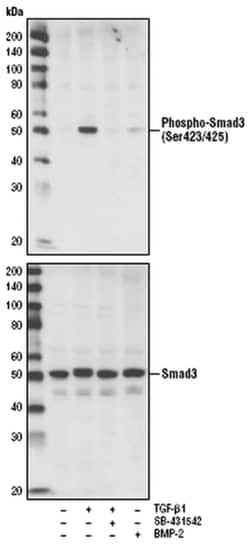Promotional price valid on web orders only. Your contract pricing may differ. Interested in signing up for a dedicated account number?
Learn More
Learn More
MilliporeSigma™ anti-PhosphoDetect™ Smad3 (pSer423/425) Clone: C25A9, Rabbit Monoclonal,
Rabbit Monoclonal Antibody
Supplier: MilliporeSigma™ PS102350UL
Description
Specifically detects PhosphoDetect™ Smad3 (pSer423/425) Clone: C25A9 in Human samples, and it is validated for Immunoprecipitation
Members of the Smad family of signal transduction molecules are components of a critical intracellular pathway that transmits TGF-β signals from the cell surface to the nucleus. Three distinct classes of Smads have been defined: the receptor-regulated Smads (R-Smads), which include Smad1, 2, 3, 5 and 8, the common-mediator Smad (co-Smad), Smad4, and the antagonistic or inhibitory Smads (I-Smads), Smad6 and 7. Activated type I receptors associate with specific R-Smads and phosphorylate them on a conserved carboxy-terminal SSXS motif. The phosphorylated R-Smad dissociates from the receptor and forms a heteromeric complex with the co-Smad (Smad4), allowing translocation of the complex to the nucleus. Once in the nucleus, Smads can target a variety of DNA binding proteins to regulate transcriptional responses. Following stimulation by TGF-β, Smad2 and Smad3 become phosphorylated at carboxyl terminal serine residues (Ser465/467 on Smad2; Ser423/425 on Smad3) by TGF-β Receptor I. Phosphorylated Smad 2/3 can complex with Smad4 and translocate to the nucleus to regulate gene expression.
Specifications
| PhosphoDetect™ Smad3 (pSer423/425) | |
| Monoclonal | |
| Unconjugated | |
| Rabbit | |
| 50 μL | |
| Primary | |
| Human | |
| Purified |
| Immunoprecipitation | |
| C25A9 | |
| In 150mM NaCl, 10mM HEPES, 100μg/ml BSA, 50% glycerol pH 7.5. | |
| a synthetic phosphopeptide corresponding to amino acids surrounding the Ser 423/425 phosphorylation sites of Smad3, coupled to KLH. | |
| RUO | |
| Recognizes the ∽52kDa Smad3 protein phosphorylated at Ser423/425 in HT-1080 cells treated with TGF-β1. | |
| −20°C | |
| IgG |
Product Content Correction
Your input is important to us. Please complete this form to provide feedback related to the content on this product.
Product Title
For Research Use Only
Spot an opportunity for improvement?Share a Content Correction
